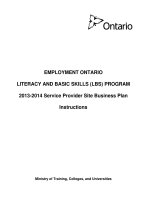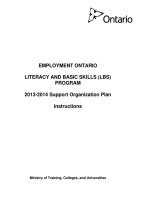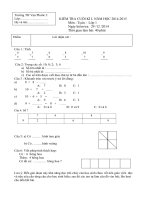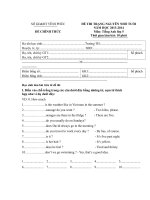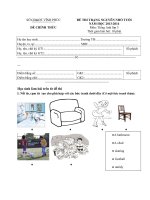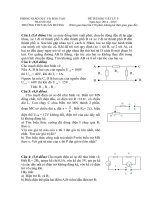Marsha m linehan phd abpp dbt® skills training handouts and worksheets, skills training handouts press (2014)
Bạn đang xem bản rút gọn của tài liệu. Xem và tải ngay bản đầy đủ của tài liệu tại đây (4.85 MB, 446 trang )
ebook
THE GUILFORD PRESS
DBT ® Skills Training Handouts and Worksheets
Also from Marsha M. Linehan
Books for Professionals
Cognitive-Behavioral Treatment of Borderline Personality Disorder
DBT Skills Training Manual, Second Edition
Dialectical Behavior Therapy with Suicidal Adolescents
Alec L. Miller, Jill H. Rathus, and Marsha M. Linehan
Mindfulness and Acceptance:
Expanding the Cognitive-Behavioral Tradition
Edited by Steven C. Hayes, Victoria M. Follette, and Marsha M. Linehan
Videos
Crisis Survival Skills, Part One: Distracting and Self-Soothing
Crisis Survival Skills, Part Two: Improving the Moment and Pros and Cons
From Suffering to Freedom: Practicing Reality Acceptance
Getting a New Client Connected to DBT (Complete Series)
Opposite Action: Changing Emotions You Want to Change
This One Moment: Skills for Everyday Mindfulness
Treating Borderline Personality Disorder: The Dialectical Approach
Understanding Borderline Personality: The Dialectical Approach
For more information and for DBT skills updates from the author,
see her websites:
www.linehaninstitute.org, /> and />
DBT ® Skills
Training
Handouts
and Worksheets
Second Edition
Marsha M. Linehan
THE GUILFORD PRESS
New York London
© 2015 Marsha M. Linehan
Published by The Guilford Press
A Division of Guilford Publications, Inc.
72 Spring Street, New York, NY 10012
www.guilford.com
All rights reserved
Except as indicated on page 4, no part of this book may be reproduced, translated, stored
in a retrieval system, or transmitted, in any form or by any means, electronic, mechanical,
photocopying, microfilming, recording, or otherwise, without written permission from the
publisher.
Printed in the United States of America
This book is printed on acid-free paper.
Last digit is print number: 9 8 7 6 5 4 3 2 1
The author has checked with sources believed to be reliable in her efforts to provide
information that is complete and generally in accord with the standards of practice that are
accepted at the time of publication. However, in view of the possibility of human error or
changes in behavioral, mental health, or medical sciences, neither the author, nor the editor
and publisher, nor any other party who has been involved in the preparation or publication
of this work warrants that the information contained herein is in every respect accurate or
complete, and they are not responsible for any errors or omissions or the results obtained from
the use of such information. Readers are encouraged to confirm the information contained in
this book with other sources.
Library of Congress Cataloging-in-Publication Data
Linehan, Marsha.
DBT skills training handouts and worksheets / Marsha M. Linehan. — Second edition.
pages cm
Includes bibliographical references and index.
ISBN 978-1-57230-781-0 (paperback)
1. Dialectical behavior therapy—Problems, exercises, etc. I. Title.
RC489.B4L56 2015
616.89'1420076—dc23
2014026331
DBT is a registered trademark of Marsha M. Linehan.
When I am on retreats, each afternoon I walk and
wring my hands, saying to all the mental health
patients of the world, “You don’t have to wring
your hands today. I am doing it for you.” Often
when I dance in the hallway of my house or with
groups, I invite all the mental health patients of the
world to come dance with me.
This book is dedicated to all the patients of the
world who think that no one is thinking of them.
I considered telling you that I would practice skills
for you so you don’t have to practice them. But then
I realized that if I did, you would not learn how to
be skillful yourself. So, instead, I wish you skillful
means, and I wish that you find these skills useful.
About the Author
Marsha M. Linehan, PhD, ABPP, is the developer of Dialectical Behavior Ther-
apy (DBT) and Professor of Psychology and of Psychiatry and Behavioral Sciences
and Director of the Behavioral Research and Therapy Clinics at the University of
Washington. Her primary research interest is in the development and evaluation
of evidence-based treatments for populations with high suicide risk and multiple,
severe mental disorders.
Dr. Linehan’s contributions to suicide research and clinical psychology research
have been recognized with numerous awards, including the Gold Medal Award for
Life Achievement in the Application of Psychology from the American Psychological
Foundation and the James McKeen Cattell Award from the Association for Psy-
chological Science. In her honor, the American Association of Suicidology created
the Marsha Linehan Award for Outstanding Research in the Treatment of Suicidal
Behavior.
She is a Zen master and teaches mindfulness and contemplative practices via
workshops and retreats for health care providers.
vi
Preface
Since the publication of the original Dialectical Behavior Therapy (DBT) skills train-
ing manual in 1993, there has been an explosion of research on the applications of
DBT across disorders. My pilot and first DBT study focused on the treatment of
highly suicidal adults. Now, we have research demonstrating the efficacy of DBT
skills training with suicidal adolescents, as well as adults with borderline personal-
ity disorder, eating disorders, treatment-resistant depression, substance use, and a
variety of other disorders. A diagnosis of a mental disorder is not required, however,
to benefit from DBT skills. Friends and family members of individuals with difficul-
ties will find these skills helpful; kids in elementary school through high school can
gain from these skills. Businesses will find DBT skills useful in creating better work
environments. All the DBT therapists I know practice these skills in their own lives
on a routine basis. I myself am grateful for the skills because they have made my life
a lot easier. As someone once said to me, “Aren’t these skills your mother was sup-
posed to teach you?” I always say yes, but for many people their mother just did not
or was not able to get around to it.
I developed many of the skills by reading treatment manuals and treatment lit-
erature on evidence-based behavioral interventions. I reviewed what therapists told
their patients to do and then repackaged those instructions in skills handouts and
worksheets and wrote teaching notes for therapists. For example, the skill “oppo-
site action” is a set of instructions based on exposure-based treatments for anxiety
disorders. The major change was to generalize the strategies to fit treatment of emo-
tions other than anxiety. “Check the facts” is a core strategy in cognitive therapy
interventions. The mindfulness skills were a product of my 19 years in Catholic
schools, my training in contemplative prayer practices through the Shalem Institute’s
spiritual guidance program, and my 35 years as a Zen student—and now Zen mas-
ter. Mindfulness of current thoughts also draws from acceptance and commitment
therapy. In general, DBT skills are what behavior therapists tell clients to do across
many effective treatments. Some of the skills repurpose entire treatment programs
now formulated as a series of steps. The new “nightmare protocol,” an emotion
regulation skill, is an example of this. Other skills came from research in cognitive
and social psychology. Still others came from colleagues developing new DBT skills
vii
viii • Preface
for new populations. As you can see, these skills came from many different sources
and disciplines.
I am happy to present this skills training manual for clients, which includes
all of the handouts and worksheets I have developed so far in DBT. (Stay tuned for
more.) You are not likely to need to use all of the skills I have included. Every skill
works for someone and no skill works for everyone. The skills in this book have
been tested with a huge variety of people: adults, adolescents, parents, friends, and
families, both high risk and low. I hope the skills are just what you need. Use your
interpersonal skills (see the DEAR MAN GIVE FAST skills in the Interpersonal
Effectiveness skills module) to talk your skills trainer or other teacher into teaching
you skills not ordinarily covered in skills training if you want to learn them. If you
should decide to venture forth on your own, I must tell you that we have no research
on the effectiveness of this skills manual as a self-help workbook or self-treatment
manual. I am hoping to write a self-help treatment book in the future, so keep your
eyes open for that. Meanwhile, you might be interested in the skills videos avail-
able through The Guilford Press or The Linehan Institute and listed on page ii of
this manual. They themselves do not constitute treatment, but we know that many
people have nonetheless found them useful, even though we have not collected data
on them. On your own or with the help of a skills teacher, I wish you skillful means.
Acknowledgments
Developing, researching, testing, and organizing the behavioral skills in this book
has been a process that has unfolded over many years. Over these years many people
made important contributions to what finally became this set of skills and work-
sheets. Here I want to thank a long line of teachers, colleagues, students, post
doctoral fellows, and clients, who for many years have been in dialogue with me on
how to best develop, organize, explain, and disseminate behavioral skills to those in
need of skillful means.
I want to acknowledge Rev. Pat Hawk and Rev. Willigis Yaeger, who were my
contemplative prayer and Zen teachers, and Anselm Romb, my Franciscan spiritual
guide, who taught me to let go of words. Each of them listened to me for hours as I
sorted out how to practice and how to teach mindfulness. My mentors, Gerald Davi-
son and Marvin Goldfried, taught me behavior therapy, and through them I was
introduced to evidence-based treatments, where I found most of the skillful means
that I condensed into the skills in this book. I extend my gratitude to Jon Kabat-Zinn,
John Teasdale, Mark Williams, and Zindel Segal for inspiration. I especially want to
thank my students and former students (in alphabetical order), Milton Brown, Anita
Lungu, Andrada Neacsiu, Shireen Rizvi, Stephanie Thompson, Chelsey Wilks, Bri-
anna Woods; and my fellows and former fellows, Alex Chapman, Eunice Chen,
Melanie Harned, Erin Miga, Marivi Navarro, and Nick Salsman. Many others have
jumped in when asked, colleagues Seth Axelrod, Kate Comtois and her entire DBT
team, Sona Dimidjian, Anthony Dubose, Thomas Lynch, and Suzanne Witterholt,
as well as the Linehan Institute scientific advisory committee (Martin Bohus, Alan
Fruzzetti, André Ivanoff, Kathryn Korslund, and Shelley McMain). I could not have
written this book without the help of Elaine Franks, my fabulous administrative
assistant, and Thao Truong, our office and financial manager, who made sure that
our research clinic did not fall apart while everyone was waiting for me to finish this
book. My family, Geraldine, Nate, Catalina, and Aline, made life easy at every turn
no matter the stress—not a minor contribution to getting a book written.
Much of what is in this manual I learned from the many clients who partici-
pated in skills training groups that I have conducted over the years. I am grateful to
all those who put up with the many versions that did not work or were not useful,
ix
x • Acknowledgments
and to those among them who gave enough feedback for me to make needed revi-
sions in the skills being taught.
The clients who gave feedback were, for the most part, individuals at high risk
for suicide. I thank the University of Washington Human Subjects Division, which
has never even once impeded my research treating individuals at extremely high risk
for suicide. Their willingness to allow such high-risk research when other universi-
ties often do not sets an example and made this book possible.
Last, but certainly not least, I want to thank my copy editor, Marie Sprayberry,
Senior Editor Barbara Watkins, Executive Editor Kathyrn Moore, and the staff at
The Guilford Press. In getting this manual out in a timely fashion they each had
occasion to practice all the distress tolerance skills in this book. Their concern for
this book and for this form of treatment was evident at every step.
Alas, it is likely that I have forgotten or accidently left out one or more individu-
als who have contributed to this book. If so, please let me know so I can include you
in future editions.
Contents
Introduction to This Book 1
General Skills: Orientation and Analyzing Behavior
General Handouts
Orientation Handouts
General Handout 1: Goals of Skills Training (General Worksheet 1) 9
General Handout 1a: Options for Solving Any Problem 10
General Handout 2: Overview—Introduction to Skills Training 11
General Handout 3: Guidelines for Skills Training 12
General Handout 4: Skills Training Assumptions 13
General Handout 5: Biosocial Theory 14
Handouts for Analyzing Behavior
General Handout 6: Overview—Analyzing Behavior 19
(General Worksheets 2, 3)
General Handout 7: Chain Analysis (General Worksheets 2, 2a) 20
General Handout 7a: Chain Analysis, Step by Step 21
(General Worksheets 2, 2a)
General Handout 8: Missing-Links Analysis (General Worksheet 3) 23
General Worksheets
Orientation Worksheet
General Worksheet 1: Pros and Cons of Using Skills (General Handout 1) 27
Worksheets for Analyzing Behavior
General Worksheet 2: Chain Analysis of Problem Behavior 31
(General Handouts 7, 7a)
General Worksheet 2a: Example—Chain Analysis of Problem Behavior 35
(General Handouts 7, 7a)
General Worksheet 3: Missing-Links Analysis (General Handout 8) 38
xi
xii • Contents
Mindfulness Skills
Mindfulness Handouts
Handouts for Goals and Definitions
Mindfulness Handout 1: Goals of Mindfulness Practice 45
(Mindfulness Worksheet 1)
Mindfulness Handout 1a: Mindfulness Definitions 46
Handouts for Core Mindfulness Skills
Mindfulness Handout 2: Overview—Core Mindfulness Skills 49
(Mindfulness Worksheets 2–2c, 3)
Mindfulness Handout 3: Wise Mind—States of Mind 50
(Mindfulness Worksheet 3)
Mindfulness Handout 3a: Ideas for Practicing Wise Mind 51
(Mindfulness Worksheet 3)
Mindfulness Handout 4: Taking Hold of Your Mind—“What” Skills 53
(Mindfulness Worksheets 2–2c, 4–4b)
Mindfulness Handout 4a: Ideas for Practicing Observing 54
(Mindfulness Worksheets 2–2c, 4–4b)
Mindfulness Handout 4b: Ideas for Practicing Describing 58
(Mindfulness Worksheets 2–2c, 4–4b)
Mindfulness Handout 4c: Ideas for Practicing Participating 59
(Mindfulness Worksheets 2–2c, 4–4b)
Mindfulness Handout 5: Taking Hold of Your Mind—“How” Skills 60
(Mindfulness Worksheets 2–2c, 5–5c)
Mindfulness Handout 5a: Ideas for Practicing Nonjudgmentalness 61
(Mindfulness Worksheets 2–2c, 5–5c)
Mindfulness Handout 5b: Ideas for Practicing One-Mindfulness 62
(Mindfulness Worksheets 2–2c, 5–5c)
Mindfulness Handout 5c: Ideas for Practicing Effectiveness 63
(Mindfulness Worksheets 2–2c, 5–5c)
Handouts for Other Perspectives on Mindfulness Skills
Mindfulness Handout 6: Overview—Other Perspectives on Mindfulness 67
(Mindfulness Worksheets 6–10b)
Mindfulness Handout 7: Goals of Mindfulness Practice—A Spiritual 68
Perspective (Mindfulness Worksheet 1)
Mindfulness Handout 7a: Wise Mind from a Spiritual Perspective 69
Mindfulness Handout 8: Practicing Loving Kindness to Increase 70
Love and Compassion (Mindfulness Worksheet 6)
Mindfulness Handout 9: Skillful Means—Balancing Doing Mind 71
and Being Mind (Mindfulness Worksheets 7–9)
Mindfulness Handout 9a: Ideas for Practicing Balancing Doing Mind 72
and Being Mind (Mindfulness Worksheets 7–9)
Mindfulness Handout 10: Walking the Middle Path—Finding the 74
Synthesis between Opposites (Mindfulness Worksheets 10–10b)
Contents • xiii
Mindfulness Worksheets
Worksheets for Core Mindfulness Skills
Mindfulness Worksheet 1: Pros and Cons of Practicing Mindfulness 77
(Mindfulness Handouts 1, 7)
Mindfulness Worksheet 2: Mindfulness Core Skills Practice 78
(Mindfulness Handouts 2–5c)
Mindfulness Worksheet 2a: Mindfulness Core Skills Practice 79
(Mindfulness Handouts 2–5c)
Mindfulness Worksheet 2b: Mindfulness Core Skills Practice 80
(Mindfulness Handouts 2–5c)
Mindfulness Worksheet 2c: Mindfulness Core Skills Calendar 81
(Mindfulness Handouts 2–5c)
Mindfulness Worksheet 3: Wise Mind Practice 83
(Mindfulness Handouts 3, 3a)
Mindfulness Worksheet 4: Mindfulness “What” Skills— 84
Observing, Describing, Participating (Mindfulness Handouts 4–4c)
Mindfulness Worksheet 4a: Observing, Describing, Participating Checklist 85
(Mindfulness Handouts 4–4c)
Mindfulness Worksheet 4b: Observing, Describing, Participating 86
Calendar (Mindfulness Handouts 4–4c)
Mindfulness Worksheet 5: Mindfulness “How” Skills— 88
Nonjudgmentalness, One-Mindfulness, Effectiveness
(Mindfulness Handouts 5–5c)
Mindfulness Worksheet 5a: Nonjudgmentalness, One-Mindfulness, 89
Effectiveness Checklist (Mindfulness Handouts 5–5c)
Mindfulness Worksheet 5b: Nonjudgmentalness, One-Mindfulness, 90
Effectiveness Calendar (Mindfulness Handouts 5–5c)
Mindfulness Worksheet 5c: Nonjudgmentalness Calendar 92
(Mindfulness Handouts 5–5c)
Worksheets for Other Perspectives on Mindfulness Skills
Mindfulness Worksheet 6: Loving Kindness (Mindfulness Handout 8) 97
Mindfulness Worksheet 7: Balancing Being Mind with Doing Mind 98
(Mindfulness Handouts 9, 9a)
Mindfulness Worksheet 7a: Mindfulness of Being and Doing Calendar 99
(Mindfulness Handouts 9, 9a)
Mindfulness Worksheet 8: Mindfulness of Pleasant Events Calendar 101
(Mindfulness Handouts 9, 9a)
Mindfulness Worksheet 9: Mindfulness of Unpleasant Events Calendar 103
(Mindfulness Handouts 9, 9a)
Mindfulness Worksheet 10: Walking the Middle Path to Wise Mind 105
(Mindfulness Handouts 3, 10)
Mindfulness Worksheet 10a: Analyzing Yourself on the Middle Path 106
(Mindfulness Handout 10)
Mindfulness Worksheet 10b: Walking the Middle Path Calendar 107
(Mindfulness Handout 10)
xiv • Contents
Interpersonal Effectiveness Skills
Interpersonal Effectiveness Handouts
Handouts for Goals and Factors That Interfere
Interpersonal Effectiveness Handout 1: Goals of Interpersonal 117
Effectiveness (Interpersonal Effectiveness Worksheet 1)
Interpersonal Effectiveness Handout 2: Factors in the Way 118
of Interpersonal Effectiveness
Interpersonal Effectiveness Handout 2a: Myths in the Way 119
of Interpersonal Effectiveness (Interpersonal Effectiveness
Worksheet 2)
Handouts for Obtaining Objectives Skillfully
Interpersonal Effectiveness Handout 3: Overview— 123
Obtaining Objectives Skillfully
Interpersonal Effectiveness Handout 4: Clarifying Goals in Interpersonal 124
Situations (Interpersonal Effectiveness Worksheet 3)
Interpersonal Effectiveness Handout 5: Guidelines for Objectives 125
Effectiveness—Getting What You Want (DEAR MAN)
(Interpersonal Effectiveness Worksheets 4, 5)
Interpersonal Effectiveness Handout 5a: Applying DEAR MAN Skills 127
to a Difficult Current Interaction
Interpersonal Effectiveness Handout 6: Guidelines for Relationship 128
Effectiveness—Keeping the Relationship (GIVE)
(Interpersonal Effectiveness Worksheets 4, 5)
Interpersonal Effectiveness Handout 6a: Expanding the V in GIVE— 129
Levels of Validation
Interpersonal Effectiveness Handout 7: Guidelines for Self-Respect 130
Effectiveness—Keeping Respect for Yourself (FAST)
(Interpersonal Effectiveness Worksheets 4, 5)
Interpersonal Effectiveness Handout 8: Evaluating Options 131
for Whether or How Intensely to Ask for Something or Say No
(Interpersonal Effectiveness Worksheet 6)
Interpersonal Effectiveness Handout 9: Troubleshooting—When What 134
You Are Doing Isn’t Working (Interpersonal Effectiveness
Worksheet 7)
Handouts for Building Relationships and Ending Destructive Ones
Interpersonal Effectiveness Handout 10: Overview— 139
Building Relationships and Ending Destructive Ones
Interpersonal Effectiveness Handout 11: Finding and Getting People 140
to Like You (Interpersonal Effectiveness Worksheet 8)
Interpersonal Effectiveness Handout 11a: Identifying Skills to Find People 142
and Get Them to Like You
Interpersonal Effectiveness Handout 12: Mindfulness of Others 143
(Interpersonal Effectiveness Worksheet 9)
Interpersonal Effectiveness Handout 12a: Identifying Mindfulness 144
of Others
Contents • xv
Interpersonal Effectiveness Handout 13: Ending Relationships 145
(Interpersonal Effectiveness Worksheet 10)
Interpersonal Effectiveness Handout 13a: Identifying How 146
to End Relationships
Handouts for Walking the Middle Path
Interpersonal Effectiveness Handout 14: Overview—Walking the Middle 149
Path (Interpersonal Effectiveness Worksheets 11–15c)
Interpersonal Effectiveness Handout 15: Dialectics 150
(Interpersonal Effectiveness Worksheets 11–11b)
Interpersonal Effectiveness Handout 16: How to Think and Act 151
Dialectically (Interpersonal Effectiveness Worksheets 11–11b)
Interpersonal Effectiveness Handout 16a: Examples of Opposite Sides 152
That Can Both Be True
Interpersonal Effectiveness Handout 16b: Important Opposites 153
to Balance
Interpersonal Effectiveness Handout 16c: Identifying Dialectics 154
Interpersonal Effectiveness Handout 17: Validation 155
(Interpersonal Effectiveness Worksheet 12)
Interpersonal Effectiveness Handout 18: A “How To” Guide to Validation 156
(Interpersonal Effectiveness Worksheet 12)
Interpersonal Effectiveness Handout 18a: Identifying Validation 157
Interpersonal Effectiveness Handout 19: Recovering from Invalidation 158
(Interpersonal Effectiveness Worksheet 13)
Interpersonal Effectiveness Handout 19a: Identifying Self-Validation 160
Interpersonal Effectiveness Handout 20: Strategies for Increasing 161
the Probability of Behaviors You Want (Interpersonal Effectiveness
Worksheet 14)
Interpersonal Effectiveness Handout 21: Strategies for Decreasing 162
or Stopping Unwanted Behaviors (Interpersonal Effectiveness
Worksheet 15)
Interpersonal Effectiveness Handout 22: Tips for Using Behavior Change 163
Strategies Effectively (Interpersonal Effectiveness Worksheets 14, 15)
Interpersonal Effectiveness Handout 22a: Identifying Effective Behavior 164
Change Strategies
Interpersonal Effectiveness Worksheets
Worksheets for Goals and Factors That Interfere
Interpersonal Effectiveness Worksheet 1: Pros and Cons of Using 167
Interpersonal Effectiveness Skills (Interpersonal Effectiveness
Handout 1)
Interpersonal Effectiveness Worksheet 2: Challenging Myths in the Way 168
of Obtaining Objectives (Interpersonal Effectiveness Handout 2a)
Worksheets for Obtaining Objectives Skillfully
Interpersonal Effectiveness Worksheet 3: Clarifying Priorities 173
in Interpersonal Situations (Interpersonal Effectiveness Handout 4)
xvi • Contents
Interpersonal Effectiveness Worksheet 4: Writing Out Interpersonal 174
Effectiveness Scripts (Interpersonal Effectiveness Handouts 5, 6, 7)
Interpersonal Effectiveness Worksheet 5: Tracking Interpersonal 175
Effectiveness Skills Use (Interpersonal Effectiveness Handouts 5, 6, 7)
Interpersonal Effectiveness Worksheet 6: The Dime Game—Figuring Out 176
How Strongly to Ask or Say No (Interpersonal Effectiveness
Handout 8)
Interpersonal Effectiveness Worksheet 7: Troubleshooting Interpersonal 178
Effectiveness Skills (Interpersonal Effectiveness Handout 9)
Worksheets for Building Relationships and Ending Destructive Ones
Interpersonal Effectiveness Worksheet 8: Finding and Getting People to 183
Like You (Interpersonal Effectiveness Handout 11)
Interpersonal Effectiveness Worksheet 9: Mindfulness of Others 184
(Interpersonal Effectiveness Handout 12)
Interpersonal Effectiveness Worksheet 10: Ending Relationships 185
(Interpersonal Effectiveness Handout 13)
Worksheets for Walking the Middle Path
Interpersonal Effectiveness Worksheet 11: Practicing Dialectics 189
(Interpersonal Effectiveness Handouts 15, 16)
Interpersonal Effectiveness Worksheet 11a: Dialectics Checklist 190
(Interpersonal Effectiveness Handouts 15, 16)
Interpersonal Effectiveness Worksheet 11b: Noticing When You’re 191
Not Dialectical (Interpersonal Effectiveness Handouts 15, 16)
Interpersonal Effectiveness Worksheet 12: Validating Others 192
(Interpersonal Effectiveness Handouts 17, 18)
Interpersonal Effectiveness Worksheet 13: Self-Validation 193
and Self-Respect (Interpersonal Effectiveness Handout 19)
Interpersonal Effectiveness Worksheet 14: Changing Behavior 194
with Reinforcement (Interpersonal Effectiveness Handouts 20, 22)
Interpersonal Effectiveness Worksheet 15: Changing Behavior 195
by Extinguishing or Punishing It (Interpersonal Effectiveness
Handouts 21–22)
Emotion Regulation Skills
Emotion Regulation Handouts
Emotion Regulation Handout 1: Goals of Emotion Regulation 205
(Emotion Regulation Worksheet 1)
Handouts for Understanding and Naming Emotions
Emotion Regulation Handout 2: Overview— 209
Understanding and Naming Emotions (Emotion Regulation
Worksheets 2–4a, 16)
Contents • xvii
Emotion Regulation Handout 3: What Emotions Do for You 210
(Emotion Regulation Worksheets 2, 2a–c)
Emotion Regulation Handout 4: What Makes It Hard to Regulate 211
Your Emotions (Emotion Regulation Worksheets 3, 16)
Emotion Regulation Handout 4a: Myths about Emotions 212
(Emotion Regulation Worksheet 3)
Emotion Regulation Handout 5: Model for Describing Emotions 213
(Emotion Regulation Worksheets 4, 4a)
Emotion Regulation Handout 6: Ways to Describe Emotions 214
(Emotion Regulation Worksheets 4, 4a)
Handouts for Changing Emotional Responses
Emotion Regulation Handout 7: Overview—Changing Emotional 227
Responses (Emotion Regulation Worksheets 5–8)
Emotion Regulation Handout 8: Check the Facts (Emotion Regulation 228
Worksheet 5)
Emotion Regulation Handout 8a: Examples of Emotions That Fit the Facts 229
(Emotion Regulation Worksheet 5)
Emotion Regulation Handout 9: Opposite Action and Problem Solving— 230
Deciding Which to Use (Emotion Regulation Worksheet 6)
Emotion Regulation Handout 10: Opposite Action (Emotion Regulation 231
Worksheet 7)
Emotion Regulation Handout 11: Figuring Out Opposite Actions 232
(Emotion Regulation Worksheet 7)
Emotion Regulation Handout 12: Problem Solving (Emotion Regulation 241
Worksheet 8)
Emotion Regulation Handout 13: Reviewing Opposite Action 242
and Problem Solving (Emotion Regulation Worksheets 6–8)
Handouts for Reducing Vulnerability to Emotion Mind
Emotion Regulation Handout 14: Overview—Reducing Vulnerability 247
to Emotion Mind: Building a Life Worth Living (Emotion Regulation
Worksheets 9–14b)
Emotion Regulation Handout 15: Accumulating Positive Emotions— 248
Short Term (Emotion Regulation Worksheets 9, 10, 13)
Emotion Regulation Handout 16: Pleasant Events List 249
(Emotion Regulation Worksheets 9, 10, 13)
Emotion Regulation Handout 17: Accumulating Positive Emotions— 252
Long Term (Emotion Regulation Worksheets 9, 11–11b, 13)
Emotion Regulation Handout 18: Values and Priorities List 253
(Emotion Regulation Worksheets 10, 12, 13)
Emotion Regulation Handout 19: Build Mastery and Cope Ahead 256
(Emotion Regulation Worksheets 12, 13)
Emotion Regulation Handout 20: Taking Care of Your Mind by Taking 257
Care of Your Body (Emotion Regulation Worksheets 9, 14)
xviii • Contents
Emotion Regulation Handout 20a: Nightmare Protocol, Step by Step— 258
When Nightmares Keep You from Sleeping (Emotion Regulation
Worksheet 14a)
Emotion Regulation Handout 20b: Sleep Hygiene Protocol 259
(Emotion Regulation Worksheet 14b)
Handouts for Managing Really Difficult Emotions
Emotion Regulation Handout 21: Overview—Managing Really Difficult 263
Emotions (Emotion Regulation Worksheets 15–16)
Emotion Regulation Handout 22: Mindfulness of Current Emotions— 264
Letting Go of Emotional Suffering (Emotion Regulation Worksheet
15)
Emotion Regulation Handout 23: Managing Extreme Emotions 265
Emotion Regulation Handout 24: Troubleshooting Emotion 266
Regulation Skills—When What You Are Doing Isn’t Working
(Emotion Regulation Worksheet 16)
Emotion Regulation Handout 25: Review of Skills for Emotion Regulation 268
Emotion Regulation Worksheets
Emotion Regulation Worksheet 1: Pros and Cons of Changing Emotions 271
(Emotion Regulation Handout 1)
Worksheets for Understanding and Naming Emotions
Emotion Regulation Worksheet 2: Figuring Out What My Emotions Are 275
Doing for Me (Emotion Regulation Handout 3)
Emotion Regulation Worksheet 2a: Example—Figuring Out What My 276
Emotions Are Doing for Me (Emotion Regulation Handout 3)
Emotion Regulation Worksheet 2b: Emotion Diary (Emotion Regulation 277
Handout 3)
Emotion Regulation Worksheet 2c: Example—Emotion Diary 278
(Emotion Regulation Handout 3)
Emotion Regulation Worksheet 3: Myths about Emotions 279
(Emotion Regulation Handout 4a)
Emotion Regulation Worksheet 4: Observing and Describing Emotions 281
(Emotion Regulation Handouts 5, 6)
Emotion Regulation Worksheet 4a: Observing and Describing Emotions 282
(Emotion Regulation Handouts 5, 6)
Worksheets for Changing Emotional Responses
Emotion Regulation Worksheet 5: Check the Facts (Emotion Regulation 285
Handouts 8, 8a)
Emotion Regulation Worksheet 6: Figuring Out How to Change 287
Unwanted Emotions (Emotion Regulation Handout 9)
Emotion Regulation Worksheet 7: Opposite Action to Change Emotions 288
(Emotion Regulation Handouts 10, 11)
Emotion Regulation Worksheet 8: Problem Solving to Change Emotions 289
(Emotion Regulation Handout 12)

